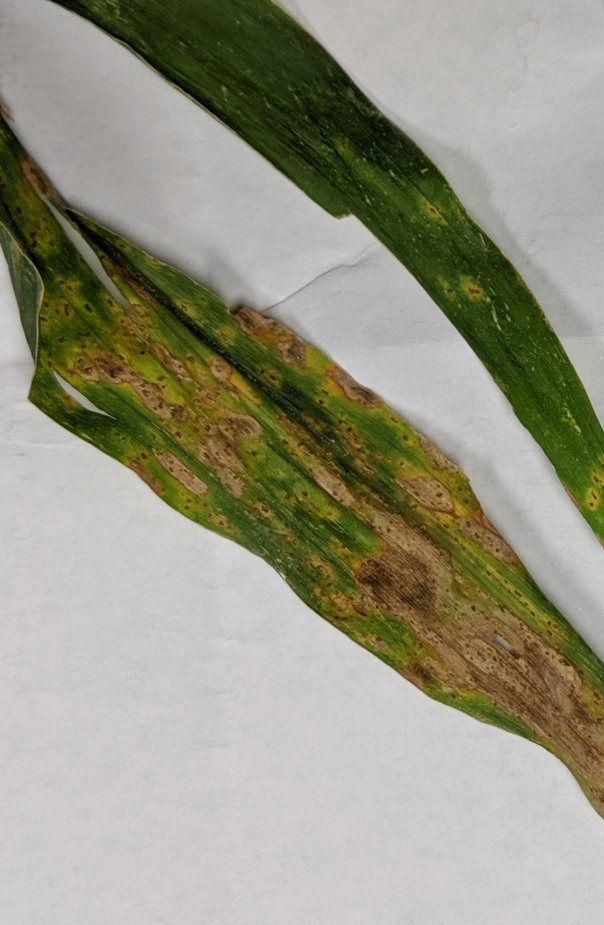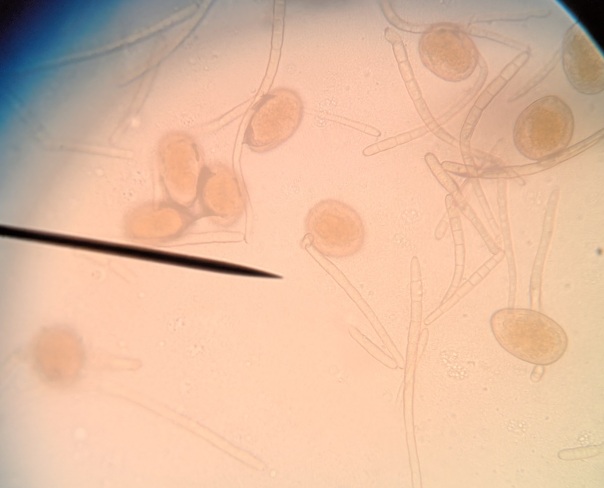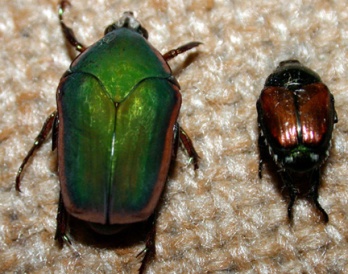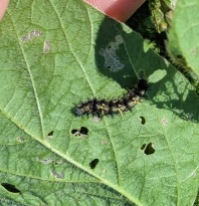Monthly Archives: July 2019
JenREES 7-28-19
Southern Rust in Nebraska was confirmed in Nuckolls, Thayer, and Fillmore counties last week. The lesions were typically on one leaf in an isolated portion of fields at low incidence and severity. I was recommending to watch the fields instead of spraying right away. Greatly appreciate everyone who has gotten samples to me this month and to neighboring Extension offices serving as drop off points for samples. I’ve been looking at samples since early July and honestly, common rust at times has exhibited signs similar to southern rust. At my blog site (https://jenreesources.com), I’ve posted photos showing the differences of common vs. southern rust that we’re seeing this year. Southern rust typically is orange to tan colored with tiny, clustered pustules on the upper leaf surface. Common rust has had an orange appearance to it at times with smaller lesions than the ‘typical’ brick red larger ones. However, in every southern rust sample I’ve confirmed, the pustules have not gone through the back of the leaf…there’s been indentations but nothing has produced pustules on the backside. That doesn’t mean that the fungus can’t; it just rarely does. Also, these leaves have all occurred in the mid-canopy. I realize lowest leaves of plants often have a great deal of rust on them, but it’s been common rust in leaf samples I’ve pulled and received to date. I’ve also posted photos of another disease called Physoderma brown spot on my blog. Physoderma is the disease that has purple/brown on the midribs, around leaf axils and sheaths and it also can have tiny yellow-brown spots without pustules that look a lot like southern rust on leaves of plants. It’s one that we tend to see around pollination as the fungus-like pathogen swims in water on the leaf surface and feeds off of decaying pollen.
Confirming southern rust in a few Nebraska counties thus far doesn’t mean that every field has it and we don’t know how it will progress. So our recommendation is to continue scouting and if you have a suspect sample, you can get it to me (if you’re in the area) or to our Plant and Pest Diagnostic Lab in Lincoln. You can keep updated with counties that are confirmed by checking out the Southern Rust tracking site at: https://corn.ipmpipe.org/southerncornrust/. The wide range of planting dates across Nebraska this year has resulted in a wide range of corn growth and reproductive stages in fields, some of which are still in the vegetative growth stages. Keep in mind that late planted fields are at particular risk for southern rust if it increases in development. Right now corn disease pressure in general is low. I’m anticipating that to soon change for gray leaf spot susceptible hybrids. Some growers added a fungicide in with an insecticide treatment for western bean cutworm, which made sense to save an application cost. However, in general, automatic fungicide applications when one treats before disease develops may lead to loss of full product efficacy before critical disease levels. This can also result in the need for reapplication later if the disease worsens after the previous fungicide application and residual has worn off. And, always in my mind is eventual potential for pathogen resistance…so utilizing fungicides when we need them vs. automatically applying is wise for maintaining these fungicide chemistries.
York County Fair: This week is the York County Fair! All events and details can be found at: http://www.yorkcountyfair.com/. One special addition this year is “Brownies for Bergen” on Saturday, August 3 from 5:30-7:00 p.m. The late Gene Bergen was a 4-H icon and was planning on celebrating 50 years as a York County Ag Society Member at this year’s fair before retiring. While he won’t be with us in person, the York County Ag Society, 4-H Council, and Extension Office would like to honor him and his original plans to celebrate. So please join us for brownies and ice cream and share your favorite memories and stories of Gene!

Lower corn leaf that is dying early and has a great deal of rust on it. So far, this has all been common rust as pictured here in spite of smaller, clustered pustules or even orange colored pustules.

Common rust spores are circular in shape.

Southern rust was confirmed on this leaf in 2019. Small, clustered, tan-orange colored pustules can be seen on this leaf.

Southern rust spores are brown and oval in shape. Sharing this photo as the clear structures are spores (condia) and spore-holding structures (conidiophores) of Cercospora zeae-maydis which causes gray leaf spot (gls) in corn. Was seeing these spores/structures with only ‘specks’ of gls lesions on this leaf. With humid weather and longer leaf wetness from dews, we may see an increase in appearance of gls lesions in the next 7-10 days.

Physoderma brown spot. Symptoms include both the purple/brown midrib in addition to the yellow-brown lesions on the leaf. These lesions are flat in comparison to southern rust which would have raised pustules.
FSA County Committee Nomination Deadline
Many Farm Service Agency county committees are seeking nominations. Brandy explains more about this opportunity to serve at a local level.
It is important for one to stand for what they believe in and takes an active role in one’s community. Effective leadership is crucial to any community or organization. An effective leader understands the issues at-hand, is knowledgeable in his/her area, knows the proper ways to motivate others, embraces change, can work in a variety of settings and with a variety of personalities, and involves the group or followers in important decision-making. That being said, remember that a leader is not only a political figure or someone that is well known, but a leader can be a farmer, local businessmen/women, or anyone in a community or organization. For those individuals desiring to take on leadership roles, consider serving on the FSA County Committee. Details for how to step into this role follow.
 Photo by Pixabay on Pexels.com
Photo by Pixabay on Pexels.com
The U.S. Department of Agriculture (USDA) Farm Service Agency (FSA) encourages all farmers…
View original post 208 more words
JenREES 7-21-19
Heat and Pollination: With last week’s heat and anticipated heat later this week, we were receiving questions regarding the impacts of heat and humidity on pollination. You can view the entire article in this week’s CropWatch at https://cropwatch.unl.edu. Key points include: Heat over 95°F depresses pollen production and prolonged periods of heat can reduce pollen production and viability. When soil moisture is sufficient, one day of 95-98°F has little or no impact on yields. After four consecutive days, there can be a 1% loss in yield for each day above that temperature. Greater yield loss potential occurs after the fifth or sixth day. High humidity, without a drop in humidity during the day, can delay pollination or prevent pollen from leaving anther sacs. We’ve been blessed we only had days of extended high heat around pollination, received a break in the heat in addition to weekend moisture.
Insect Pests: From light trap reports, peak western bean cutworm (WBC) flight appears

I’m pulling for the soldier bug predator 🙂
to have occurred last week, so scout for egg masses and live larvae with a 5-8% treatment threshold. Thistle caterpillars grew rapidly last week. Others are with me in considering spraying closer to 15% (instead of 20% threshold) with stressed fields from flash drought and/or off-target dicamba injury that don’t have canopy cover yet. In CropWatch, check out the articles regarding scouting for grasshoppers in field borders and what to expect for insects depending on crop growth stages yet this year.
Cattle Losses from High Heat: If the recent heat/humidity conditions are determined to be an extreme weather disaster event, then livestock losses would be covered by the Livestock Indemnity Program (LIP). Livestock producers who lost livestock should document losses in the expectation that they may be covered by LIP and contact your local Farm Service Agency (FSA) to report those losses.
South Central Ag Lab Field Day Aug. 1: View current field trials on improving crop production and profitability at UNL’s South Central Ag Lab (SCAL) on August 1 near Harvard. Guests can customize their day to select the tours they’re most interested in. Presentation topics include: Cover crops, pollinators and weed management; European corn borer, corn rootworm, and cover crop insect control; Herbicide-resistant weed management; Assessing injury and management decisions in corn and soybeans; Corn and soybean disease updates; Sensor-based nitrogen management in irrigated corn; Corn stover harvest management and impacts; mobile beef lab and hail machine demonstrations. Registration is at 8:30 a.m. followed by tours through 4 p.m. Lunch and refreshments are included. CCA credits have been applied for. For more info. see the program brochure and register at: https://go.unl.edu/2019scalfieldday.
Silage Webinar Aug. 2: With this year’s challenging weather and the need for forage, there may be more opportunities for harvesting corn for silage. Aimed at feedlot, cow-calf, and dairy producers, a silage webinar on August 2 at Noon CST will focus on moisture at chopping, chop length, inoculants, proper packing, silage covers and more. Pre-registration for the webinar is necessary and can be done at: https://go.unl.edu/vau7.
Trees Losing Leaves: The wet spring and humidity allowed for fungal diseases on leaves of shade trees with flowering pears and crabapples in particular dropping leaves early. I’ve also had a number of questions regarding red maple leaves (Autumn Blaze and Sunset) suddenly turning brown on trees. These symptoms may also be experienced on ash, tuliptree, and other maples. We think it’s environmental stress from having so much cool and wet early to almost a ‘flash drought’ situation in eastern Nebraska prior to this weekend’s rains. Sarah Browning has been recommending watering and mulch as the best ways to reduce stress and to prevent additional root death and tree decline. I’ve been seeing new growth starting to occur on trees so my hope is if your tree is experiencing this, that 10-14 days from now you will also see new growth occurring on your trees.
JenREES 7-14-19
Interesting, memorable don’t seem to capture this year. While portions of Nebraska are flooding again, many growers in this part of the state and east would like some rain. Dr. Suat Irmak shares on understanding matric potential and water content thresholds on sensors for irrigation scheduling in this CropWatch article: https://go.unl.edu/miym.
Soybean: The large number of painted lady butterflies we experienced in late May/June was due to a wet season in Mexico that allowed for greater vegetative growth and survival for northern migration, according to Bob Wright, Extension Entomologist. The cooler conditions may have caused more to stay here instead of move north. Saw newly hatched to early instars of thistle caterpillar (the larvae of painted lady butterflies) this week. Yet, a tremendous number of butterflies are still laying eggs. A painted lady female can lay up to 500 pale green eggs on plants individually instead of in egg masses. The larvae hatch in around a week and can feed from 2-6 weeks depending on weather conditions. Other defoliators including various worms, grasshoppers, Japanese beetles are also present. Thresholds for damage for all soybean defoliators is 20% defoliation of plants during the reproductive stages. If you’re unsure what 20% defoliation in soybean looks like, check out the graphic in CropWatch at: https://go.unl.edu/v0ts. If your primary defoliator is thistle caterpillars, it’s important to use insecticides that can be effective on them once their ‘tents’ are built. The 2019 Guide for Weed, Disease, Insect Management gives information regarding products that may work better on pages 308-314.
Gall Midge in Seward County: My colleague Aaron Nygren found soybean gall midge in

Gall midge (orange colored worm)
Seward County north of Bee this past week. I was a few miles away so met him at the field. Being a new insect pest, little is known about it. Infected plants show signs of wilting from larvae feeding within the base of the stem. These plants will eventually die. To scout for soybean gall midge, focus on plants that are close to the field edge and adjacent to fields that were planted to soybean in 2018. If you’re seeing wilted/dying plants, particularly in early planted beans this year, please contact your local Extension educator. More information at: https://cropwatch.unl.edu/gallmidge.
Bob Wright is asking for help to understand distribution of the green June beetle, Japanese beetle, and brown marmorated stink bug. If you see these insects, please take a picture and upload it to: inaturalist.org, including information on where the photo was taken. You need to make an account with inaturalist.org before you can upload photos. And, if you’re unsure what these insects look like, you can view them at: https://go.unl.edu/uzd0.
Corn: Looked at numerous corn leaves but so far, only common rust in Nebraska. Southern rust was confirmed in southern Kansas and Missouri this past week. You can view U.S. counties where southern rust has been confirmed at: https://corn.ipmpipe.org/southerncornrust/.
As we approach tasseling: 1-Areas of fields that had water ponded this

Tassels appear leafy in crazy top of corn. Took this pic from flooded waterway area in 2017.
growing season may show crazy top of corn. Crazy top symptoms include when the tassel appears strange and leafy. Plants can be barren, have barren kernels on ears, or have multiple ears at shank. 2-Automatic fungicide applications at tassel: I prefer waiting till disease warrants application & Nebraska research shows fungicide applications later in the season are effective. Be careful if you automatically spray at tassel! Canopy closure covered problems in fields, including uneven growth stages. Plants in the field may have tassels with others several growth stages behind. Arrested ear development primarily occurs on plants from 12-14 leaves when surfactants (particularly non-ionic) are applied with fungicides. So, it’s important to know your growth stages and consider what you’re applying. 3-Japanese beetles in corn threshold: Three or more Japanese beetles per ear with silks clipped to less than ½ inch and pollination is less than 50% complete. 4-It’s OK to fertigate pollinating corn. Avoid running pivot from 6 a.m.-Noon during pollination. Can apply 30 lbs N in 0.25″ water or up to 60 lbs N in 0.50″.
Linden trees and Japanese beetles: Last week I didn’t stress the importance of insecticides and impact to bees when spraying linden trees. ‘Sevin’ is effective but highly toxic to bees. It’s better to use heavy streams of water in late afternoon to knock Japanese beetles down (then drown in soapy water), pyrethroids, or permethrin like ‘Eight’ as those products are not taken back to the hives.
JenREES 7-7-19
Crop Updates: I really appreciate all those in ag industry who share what you’re seeing in the fields; it’s a blessing to have a great network of people looking at fields in different areas of the state and sharing what we’re all seeing!
Western bean cutworm (WBC) moths were seen in corn whorls the past week. They’re

Western Bean Cutworm Moth courtesy UNL CropWatch
also showing up in UNL light traps in addition to industry ones. To view the UNL light trap reports near Clay Center, please go to: https://scal.unl.edu/ltr2019.pdf. The light trap near Mead is currently having black light issues, but the report can be viewed at: https://go.unl.edu/2usz and the light trap report from North Platte is at: https://go.unl.edu/a56b. WBC moths prefer laying eggs on upper leaf surfaces in corn that is in the late whorl to early tassel stage. UNL entomologists recommend scouting at 25% of moth flight. It’s unknown how larval survival will be impacted by corn growth stage at this time. Larvae survival is highest when they have fresh tassel tissue and pollen to feed on before moving down to developing ears and silks. Larval survival is lowest when only vegetative tissue is available to feed on. So, the delayed planting and growth in some fields may allow for less western bean cutworm damage in 2019. However, our entomologists say that air and soil temperature can also impact insect development leading to slower development of the insects. UNL Entomologists Tom Hunt and Bob Wright, along with University of Minnesota researchers, developed a degree-day model to predict when WBC moths will emerge to begin mating and laying eggs. In a recent CropWatch article, they were predicting 25% moth flight to occur for the following dates/locations: July 7th in Lincoln; July 11 in Hastings and Ithaca; July 12 in Grand Island and York; July 13 in Clay Center; July 15 in Holdrege, and July 23 in North Platte. Corn expressing VIP3A proteins are highly effective for WBC control. Corn expressing Cry1F (Herculex) proteins may provide some WBC feeding suppression but shouldn’t be relied upon for control. The current UNL economic threshold for treatment is 5-8% of corn plants with eggs or larvae.
Common Rust in Corn: The rainfall, humidity, and wet canopies have allowed for
increased common rust to be seen in corn this past week. I was seeing larger numbers of pustules on lower leaves of plants, but this week could also see pustules occurring in upper canopies. Pustules of common rust are typically brick red in color, larger, more separate, and can appear on both the upper and lower leaf surfaces. Southern rust typically has smaller, orange to tan colored pustules occurring in tight clusters on upper surfaces of leaves. However, the past few years, we’ve seen common rust looking more orange in color, including this year. The best way to confirm for sure if it’s common or southern rust is to check the spores under the microscope, and I’m happy to do that. The spores of common rust will be circular in shape whereas southern rust spores are more oval to football shaped. Samples can also be submitted to the UNL Plant and Pest Diagnostic lab. So far, every sample I’ve looked at has been common rust. Southern rust hasn’t been found further than Georgia and Louisiana to my knowledge right now. We don’t typically recommend fungicides for common rust. It will be important to continue scouting for diseases with the humidity and leaf wetness we’re experiencing this year.
Lawn and Garden Questions: The wet weather has allowed slime mold (gray-black fungal growth on leaves) in patches in lawns in addition to mushrooms in lawns and landscapes. They are harmless and fungicides aren’t effective. They will go away upon drying out and with warmer weather.
Bagworms are out and it’s time to control them if you have them. The following gives more detailed info on their life cycle: https://go.unl.edu/rgju and this YouTube video shows what you’re looking for this time of year on your trees: https://jenreesources.com/2015/06/27/bagworms-in-evergreens/.
Japanese Beetles may be causing holes in Linden trees or rose leaves. They are

Green June Beetle (left) and Japanese beetle (right). Photo via Purdue Entomology.
green/brown beetles with white hairs that look like rows of white spots near each wing. Kelly Feehan in Platte County shares that “applying insecticides to lawns to control grubs will not prevent beetles from feeding on landscape plants. The product ‘Milky Spore’ sold to kill them, does not work. On landscape plants, hand picking or knocking beetles into a bucket of soapy water around 7 PM is the best time of day to do this as it prevents plants producing a distress pheromone that attracts more beetles. Japanese beetle traps work very well – IF you want to attract them to your yard – so traps are best NOT used. If a Linden tree has Japanese beetles, know these trees CANNOT be treated with Imidacloprid or other Neonicotinoid insecticides.” Carbaryl (Sevin) is effective to use for Lindens and landscape plants where it’s not feasible to remove beetles by hand.





